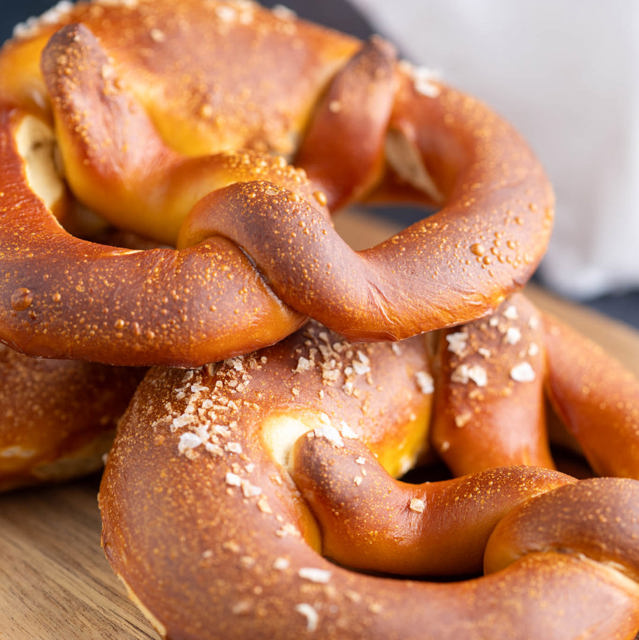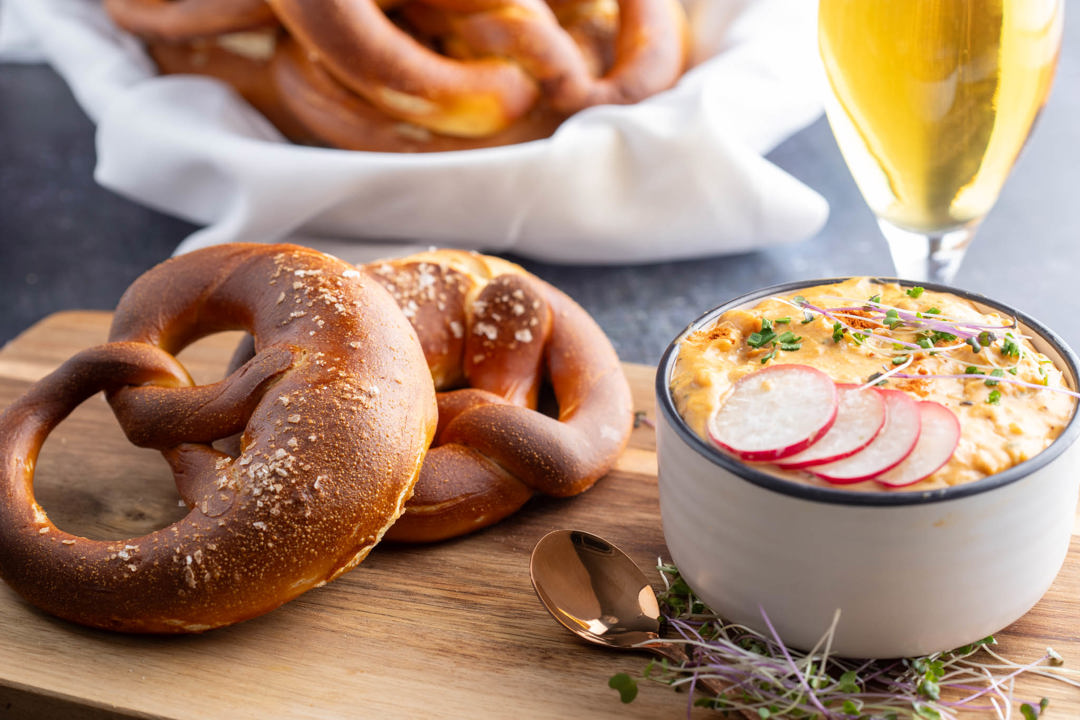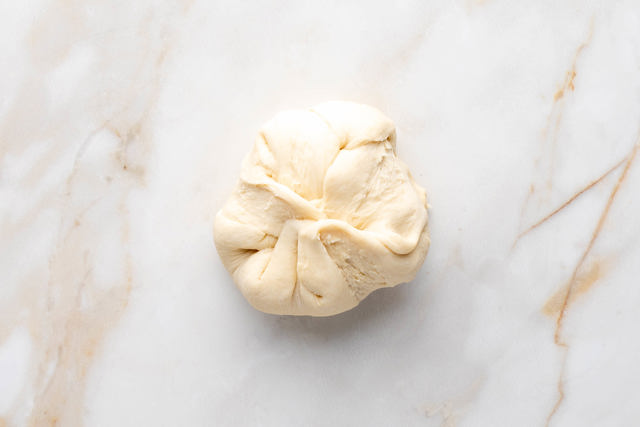Who doesn't love a warm pretzel!? Slathered in butter, spread with mustard or dipped in a German cheese & beer dip "Obatzda", pretzels are the perfect snack food. They're easy to make and are ready in under an hour.
Pretzels are quick to make because you don't need to let them rise! Just mix the ingredients together, shape them, optionally dip them in an alkaline solution, and then bake them.
If you bake bread, chances are you have everything you need at home already - and you don't need any special equipment, either. For the best results the pretzels should be dipped in an alkaline solution for which there are multiple options - lye or baking/bicarb soda. I'll explain all in this post.
Pretzel ingredients
Pretzels are made from a typical bread mix, containing:
- Flour
- Water
- Salt
- Yeast
In addition, you need:
- Coarse salt - traditionally, pretzel salt would be used. Pretzel salt is a coarse, irregularly-shaped salt which gives a crunchy texture, but can be hard to find. For this reason, I suggest using a flaky salt such as Maldon.
- Optionally, barley malt extract can be used to bring a little sweetness and malt taste to the pretzel.
Finally, for the (optional) alkaline bath you need:
- Lye - make sure you select food grade lye - don't use cleaning or industrial lye. Source from Amazon, eBay or from local baking supply shops. There are risks with lye, so check out my information on handling the lye safely.
- Baking/bicarbonate soda - a more readily available and safer alternative to lye. You won't get an authentic taste or texture, but you'll get a close approximation.
Equipment you need to make pretzels
I almost always recommend making bread using a stand mixer and write my recipes accordingly. The post has instructions to make by hand if you don't have a stand mixer.
Lye bath
If you're going to use a lye bath, you need appropriate safety equipment which includes:
- Chemical safe gloves - read your glove packaging to find gloves suitable for use in an alkaline environment.
- Safety glasses
- Long clothing to minimise the chances of getting it on your skin.
You also need a glass bowl for containing the solution - plastic and metal containers might react with the lye. There's a section later in the post for handling the lye safely.
How to make pretzels
Add dough ingredients to bowl - add the flour, yeast, salt and barley malt extract, if using, to a mixing bowl. Take care to not put the yeast and salt together. Add the water.
Knead in your stand mixer at low speed with a dough hook attachment or by hand for 8 minutes until the gluten is developed and passes the window pane test. Allow the dough to stand for 10 minutes to relax the gluten.
Divide the dough into equal sized balls. For the standard recipe quantity, divide the total dough weight by 8 which should yield balls around 125g each.
Shape - pull the corners of the dough ball into the middle (1). Place seam side down and cup with your hand. Grip loosely and roll the ball around for 5 seconds or so until it develops tension and is rounded (2). Repeat for each dough ball and place each ball on a baking paper/parchment paper lined tray.
Rest - allow the gluten to relax for 5-10 minutes to make shaping easier.
Preheat oven to 220C (430F).
Shape - shape the dough into a cylinder (1), then using your hands in a rocking motion, roll each dough ball into a rope approximately 60cm (2') in length. As you roll, gradually taper the ends of the rope by applying more pressure to the edges, ensuring they are thinner than the middle section. Then, form the rope into a U-shape (2) with the open ends facing towards you. Cross the ends over each other about halfway down the U (3) and twist them around each other once (4). Bring the twisted ends back towards the thick part of the pretzel, pressing lightly to seal (5) and ensuring the tapered ends are maintained. Transfer the shaped pretzel onto a baking tray lined with baking/parchment paper (6). Repeat for all dough balls.
Lye bath - if using a lye dip, ensure you're wearing long clothing with no exposed skin and that you wear eye protection and chemical safe gloves. Add the water to a glass bowl or container, and then add the lye crystals slowly, stirring slowly with a whisk as you do so until all the crystals are dissolved into the water.
Baking soda bath - only if not doing the lye bath - stir the baking/bicarb soda into the water and then bring to the boil
Dip pretzels - if using the lye bath, pick up each pretzel with your thumbs holding the ends of the pretzel to the thick part. Hold, submerged in the lye bath, for 15 seconds per pretzel. Gently lift the pretzel out of the lye bath and allow excess lye to drip from the pretzel. Place back on the baking tray while you finish dipping the other pretzels.
Add salt - add a sprinkle of pretzel or flakey salt over the thick part of the pretzel.
Bake - bake the pretzels in the preheated oven for 15 minutes or until golden brown and cooked through.
Tips
- If you're using active dried yeast, or If you're unsure your instant dried yeast is still alive, whisk the yeast, water and sugar together before adding to the flour and other ingredients. Allow it to stand for 10 minutes - if the yeast is alive the water will be frothy.
- Store your dried yeast in the freezer to prolong its life.
- Only use a coarse salt - table and cooking/kosher are too fine. Pretzel salt can be challenging to find, large salt flakes (i.e. Maldon) are widely available and work well.
What to serve with pretzels
Pretzels are great when served with spreads such as butter or mustard, and the favourite German cheese & beer dip "Obatzda".
It's also common to enjoy the pretzels warm straight out of the oven, or with camembert cheese.
Active dried yeast
Dried yeast comes in 2 varieties, active and instant. If you're using active dried yeast, you need to activate it before use. Simply mix the water, yeast and 1 tsp sugar together until frothy - about 10 minutes, and then proceed with the recipe.
How to knead by hand
To knead dough by hand, begin with a lightly floured surface to prevent sticking. Place the dough on the floured surface and use the heel of your hand to gently press it away from you. Fold the dough in half towards you and rotate it a quarter turn. Continue this process for about 8-10 minutes or until the dough becomes smooth, elastic, and passes the "window pane test".
To perform the window pane test, take a small piece of dough and gently stretch it between your fingers. If the dough stretches into a thin, translucent membrane without tearing, it's ready. If it tears easily, continue kneading for a few more minutes.
While you're kneading, adjust the flour as needed to maintain a slightly tacky but not overly sticky consistency.
Using a stand mixer
Use your stand mixer on a low speed - generally 1 or 2, but consult your manual to confirm - with a dough hook to knead the dough.
This is a low hydration dough which makes it difficult for a stand mixer to mix. If you have a less expensive mixer, keep an eye on it while it's kneading and stop if the motor starts to smell, gets excessively hot, stalls or is regularly slowing down. Kitchenaid mixers should be fine with this level of hydration.
Overnight fermentation
Fermenting the dough overnight rather than at room temperature will give you a stronger fermented bread taste.
To do this, place your dough mixture after kneading into the fridge. Ensure that it's airtight so that it won't dry out in the fridge - either place into a container with a lid or cover your bowl with plastic wrap.
When you're ready to continue, remove the dough from the fridge and allow to come to room temperature before you proceed with shaping.
Make ahead, reheating and freezing pretzels
Pretzels, along with all breads - are best when freshly baked. Day old pretzels are best reheated in the microwave briefly which will soften it slightly. I would suggest freezing any uneaten pretzels by the time they're a day old.
I have instructions above for overnight fermentation which can allow you to make them ahead of time. You can also shape them and then place in the fridge - make sure they're covered as if they're exposed they will dry out.
All about salt
Traditionally, a coarse grind of salt it used with pretzels. If you can find this salt, known as "pretzel salt," by all means use it. It might not be easy to source, so using a coarse flake salt such as Maldon is a good alternative.
I use salt flakes because they're widely available, but substitute it for another coarse salt if you prefer. Don't use a fine salt such as table, kosher or cooking salt for the pretzels.
Only the thick part of the pretzel is salted, and it's just a pinch - you don't want to over salt the pretzel.
All about alkalinity
Lye
Also known as sodium hydroxide, lye is a key component for making authentic German pretzels. By dipping pretzels in a lye bath, the surface is made highly alkaline which is what gives pretzels their distinctive taste, texture and appearance. This is because the highly alkaline exterior will have the Maillard reaction more quickly.
The Maillard reaction is a chemical reaction between amino acids and reducing sugars that gives browned foods their distinctive flavour and colour.
For the absolute best pretzels, there is no substitute for using lye. Make sure you source food grade lye - not lye which is used for cleaning purposes.
During the baking process, lye undergoes a chemical reaction that neutralizes its caustic properties. When pretzels are dipped in a lye solution and then baked at high temperatures, the lye reacts with carbon dioxide from the dough and the heat of the oven. By the time the pretzels are fully baked, any residual lye has been neutralized, making them safe to eat.
Lye safety
Lye is a strong alkali that can cause severe chemical burns and should be handled with great care. When using lye, it is crucial to follow safety protocols to avoid injury. Direct contact with skin or eyes can be dangerous, and inhaling its fumes can irritate the respiratory system.
Some tips for working with lye:
- Wear gloves which are suitable for handling alkaline chemicals.
- Wear long clothing to minimise the chance of getting a splash on your skin.
- Glasses are recommended to avoid getting lye into your eyes.
Neuatralising lye
Because lye is a strong base, it is easily neutralised with an acid. White, household vinegar is the easiest solution for this. If you spill any lye, quickly spray it with a bit more vinegar to neutralise the lye. You can then safely wipe it up. For each tablespoon of solution spilled, use 1.2 tbsp of vinegar to neutralise it.
If you get lye on your skin, immediately wash it off and then spray vinegar on the affected area to neutralise any remaining lye.
Making the lye bath
Always add the lye to water - adding water to lye can cause a violent exothermic reaction. Add the lye slowly, stirring as you go, until the lye is incorporated into the water and you don't see any granules.
Use 20g of lye granules to 500ml of water. This is enough for at least 24 pretzels made using my recipe.
Dipping the pretzels
Using gloved hands, carefully pick the pretzels up and lower the pretzel into the lye bath in a controlled manner, taking care to avoid any splashing. Keep the pretzel in the lye bath for 15 seconds, slowly lift it out and allow the excess lye solution to drip off. Place the pretzel on a baking/parchment paper lined baking tray and repeat until all pretzels are done.
To avoid the ends of the pretzel becoming detached while submerged, I hold the pretzel with both hands with my thumbs resting where the pretzel ends join to the thick part of the pretzel.
Disposing the lye bath
If you have sewer mains, you can safely put the lye bath down the drain. Lye is a drain cleaner, so you might have cleaner pipes afterwards! If you don't have sewer connected mains (like me!), I dig a shallow hole and dispose of it that way. Don't do this near any natural bodies of water.
Baking/bicarb soda
Baking soda (sodium bicarbonate, NaHCO3) can be used in place of lye. The resulting crust will be improved when compared to skipping alkalinity altogether, but it's still not comparable to baking with lye.
By boiling the baking/bicarb soda, it's converted to washing soda (sodium carbonate, Na2CO3), which is more alkaline than if you dipped the pretzels in cold water containing baking/bicarb soda.
Baking soda safety
Baking soda, and washing soda do not pose the same risks that lye does. With that said, handle it with caution and avoid touching it or breathing the steam in - use an extraction fan in a well ventilated area.
How to use baking soda
Add 30g (2 tbsp) of baking soda to 500ml of water. Stir well to combine and bring to the boil. Carefully place the pretzels, one at a time, into the boiling water solution. Use a turner or spider to gently keep the pretzel submerged for 20 seconds. Remove and place on a baking/parchment paper lined baking tray.
Skipping alkalinity
If you just want to bake pretzels without using an alkalinity bath, you absolutely can - they won't have their characteristic browning or taste, but they'll still be great!
Add your own touch
- Try rolling the pretzels in a seed mix with seeds like sesame, pumpkin seeds and poppy seeds. The Everything Bagel Seasoning mix works well!
- Infuse herbs such as rosemary, thyme or oregano into the dough.
- Add some cheese to the dough, such as cheddar or parmesan.
- Use spices in the dough like garlic powder, onion powder or smoked paprika.
- Experiment with different flours such as rye or whole wheat.
- Try different salts, such as garlic or truffle salt.

Pretzels
| Prep | Cook | Total |
|---|---|---|
| 45 mins | 15 mins | 60 mins |
- 630g flour
- 365ml water
- 12g salt cooking salt
- 2.5 tsp instant yeast for instructions on using active yeast, see note 1
- 1-2 tbsp barley malt extract optional, see note 2
- Flaky or pretzel salt pretzel salt can be hard to find, but a flaky finishing salt is fine - see note 3
- 500ml water
- 20g lye crystals must be food grade, see note 4
- 500ml water
- 30g (2 tbsp) baking/bicarbonate soda see note 5
- Obatzda a Bavarian cheese & beer dip
- Butter
- Mustard
- Cheese or other spreads
- Add dough ingredients to bowl - add the flour, yeast, salt and barley malt extract, if using, to a mixing bowl. Take care to not put the yeast and salt together. Add the water.
- Knead in your stand mixer at low speed with a dough hook attachment or by hand for 8 minutes until the gluten is developed and passes the window pane test. Allow the dough to stand for 10 minutes to relax the gluten.
- Divide the dough into equal sized balls. For the standard recipe quantity, divide the total dough weight by 8 which should yield balls around 125g each.
- Shape - pull the corners of the dough ball into the middle. Place seam side down and cup with your hand. Grip loosely and roll the ball around for 5 seconds or so until it develops tension and is rounded. Repeat for each dough ball and place each ball on a baking paper/parchment paper lined tray.
- Rest - allow the gluten to relax for 5-10 minutes to make shaping easier.
- Preheat oven to 220C (430F).
- Shape - using your hands in a rocking motion, roll each dough ball into a rope approximately 60cm (2') in length. As you roll, gradually taper the ends of the rope by applying more pressure to the edges, ensuring they are thinner than the middle section. Then, form the rope into a U-shape with the open ends facing towards you. Cross the ends over each other about halfway down the U and twist them around each other once. Bring the twisted ends back towards the thick part of the pretzel, pressing lightly to seal and ensuring the tapered ends are maintained. Transfer the shaped pretzel onto a baking tray lined with baking/parchment paper. Repeat for all dough balls.
- Lye bath - if using a lye dip, ensure you're wearing long clothing with no exposed skin and that you wear eye protection and chemical safe gloves. Add the water to a glass bowl or container, and then add the lye crystals slowly, stirring slowly with a whisk as you do so until all the crystals are dissolved into the water.
- Baking soda bath - only if not doing the lye bath - stir the baking/bicarb soda into the water and then bring to the boil
- Dip pretzels - if using the lye bath, pick up each pretzel with your thumbs holding the ends of the pretzel to the thick part. Hold, submerged in the lye bath, for 15 seconds per pretzel. Gently lift the pretzel out of the lye bath and allow excess lye to drip from the pretzel. Place back on the baking tray while you finish dipping the other pretzels.
- Add salt - add a sprinkle of pretzel or flakey salt over the thick part of the pretzel.
- Bake - bake the pretzels in the preheated oven for 15 minutes or until golden brown and cooked through.
- Yeast - if you're using active yeast, add the yeast to a bowl with lukewarm water and 1 tsp sugar. Mix well and add to the flour when frothy - about 10 minutes.
- Barley malt extract - is optional. It brings a little sweetness to the pretzel but more importantly it brings a very deep flavour.
- Pretzel salt - traditionally, pretzel salt would be used. Pretzel salt is a coarse, irregularly-shaped salt which gives a crunchy texture, but can be hard to find. For this reason, I suggest using a flaky salt such as Maldon, which is widely available. Don't use fine salt such as kosher/table/cooking salt for finishing the pretzel.
- Lye is the only way to get the authentic and characteristic taste, texture and appearance for pretzels. If you choose to use lye, ensure that you purchase food grade lye - source from Amazon, eBay or your local baking supply shop. Lye is highly caustic and must be handled safely - read the section on lye safety. If you're doing the lye bath, you don't need to do the baking soda bath. See the post for information on safely disposing the lye - don't put it down your sink if you're not connected to a sewer main.
- Baking soda - baking soda is a safer and more readily available option than using lye. The post has a lot of information about using baking soda. Don't use the lye bath if using baking soda.
- Alkaline bath - using bicarb/baking soda or lye bath is an optional step but will yield the best result. Lye is the best option and what is used for the authentic pretzel taste.
- Overnight bulk ferment - optional step which yields a stronger bread taste. Place kneaded dough into an airtight container and into the fridge overnight. When you're ready to continue, remove the dough from the fridge and allow to come to room temperature before you proceed with shaping.



































